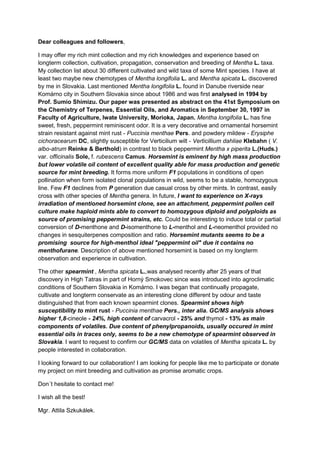Welcome
- 1. Dear colleagues and followers, I may offer my rich mint collection and my rich knowledges and experience based on longterm collection, cultivation, propagation, conservation and breeding of Mentha L. taxa. My collection list about 30 different cultivated and wild taxa of some Mint species. I have at least two maybe new chemotypes of Mentha longifolia L. and Mentha spicata L. discovered by me in Slovakia. Last mentioned Mentha longifolia L. found in Danube riverside near KomÃĄrno city in Southern Slovakia since about 1986 and was first analysed in 1994 by Prof. Sumio Shimizu. Our paper was presented as abstract on the 41st Symposium on the Chemistry of Terpenes, Essential Oils, and Aromatics in September 30, 1997 in Faculty of Agriculture, Iwate University, Morioka, Japan. Mentha longifolia L. has fine sweet, fresh, peppermint reminiscent odor. It is a very decorative and ornamental horsemint strain resistant against mint rust - Puccinia menthae Pers. and powdery mildew - Erysiphe cichoracearum DC, slightly susceptible for Verticilium wilt - Verticillium dahliae Klebahn ( V. albo-atrum Reinke & Berthold) in contrast to black peppermint Mentha x piperita L.(Huds.) var. officinalis Sole, f. rubescens Camus. Horsemint is eminent by high mass production but lower volatile oil content of excellent quality able for mass production and genetic source for mint breeding. It forms more uniform F1 populations in conditions of open pollination when form isolated clonal populations in wild, seems to be a stable, homozygous line. Few F1 declines from P generation due casual cross by other mints. In contrast, easily cross with other species of Mentha genera. In future, I want to experience on X-rays irradiation of mentioned horsemint clone, see an attachment, peppermint pollen cell culture make haploid mints able to convert to homozygous diploid and polyploids as source of promising peppermint strains, etc. Could be interesting to induce total or partial conversion of D-menthone and D-isomenthone to L-menthol and L-neomenthol provided no changes in sesquiterpenes composition and ratio. Horsemint mutants seems to be a promising source for high-menthol ideal "peppermint oil" due it contains no menthofurane. Description of above mentioned horsemint is based on my longterm observation and experience in cultivation. The other spearmint , Mentha spicata L.,was analysed recently after 25 years of that discovery in High Tatras in part of HornÃ― Smokovec since was introduced into agroclimatic conditions of Southern Slovakia in KomÃĄrno. I was began that continually propagate, cultivate and longterm conservate as an interesting clone different by odour and taste distinguished that from each known spearmint clones. Spearmint shows high susceptibility to mint rust - Puccinia menthae Pers., inter alia. GC/MS analysis shows higher 1,8-cineole - 24%, high content of carvacrol - 25% and thymol - 13% as main components of volatiles. Due content of phenylpropanoids, usually occured in mint essential oils in traces only, seems to be a new chemotype of spearmint observed in Slovakia. I want to request to confirm our GC/MS data on volatiles of Mentha spicata L. by people interested in collaboration. I looking forward to our collaboration! I am looking for people like me to participate or donate my project on mint breeding and cultivation as promise aromatic crops. DonÂīt hesitate to contact me! I wish all the best! Mgr. Attila SzkukÃĄlek.

